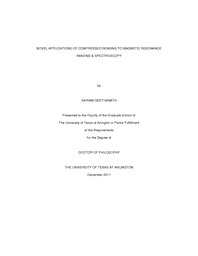
ATTENTION: The works hosted here are being migrated to a new repository that will consolidate resources, improve discoverability, and better show UTA's research impact on the global community. We will update authors as the migration progresses. Please see MavMatrix for more information.
Show simple item record
| dc.contributor.author | Geethanath, Sairam | en_US |
| dc.date.accessioned | 2012-04-11T20:54:51Z | |
| dc.date.available | 2012-04-11T20:54:51Z | |
| dc.date.issued | 2012-04-11 | |
| dc.date.submitted | January 2011 | en_US |
| dc.identifier.other | DISS-11426 | en_US |
| dc.identifier.uri | http://hdl.handle.net/10106/9532 | |
| dc.description.abstract | In this work, three novel applications of compressed sensing to MRI have been developed and implemented which accomplish reduction in acquisition time, thereby also enabling increased spatial and/or temporal resolution. The first application is for reducing the acquisition time of conventional 1H magnetic resonance spectroscopic imaging (MRSI), which requires alongeracquisition time than conventional MRI. The implementation involved exploiting the inherent sparsity of the MRSI data in the wavelet domain by the use of Daubechies wavelet. This was demonstrated on an in vitro phantom, 6 healthy human brain MRSI data sets, 2 brain and prostate cancer data sets. The reconstructions were quantified by the use of the root-mean-square-error metric and subsequent statistical comparison of the metabolite intensities based on one-way ANOVA followed by Bonferroni's multiple comparison test. It was found that the implementation resulted in statistically significant differences at an acceleration of 10X and was considered the limit of the implementation. The implementation showed no significant differences until 5X. This indicates that CS has a potential to reduce conventional MRSI acquisition time by ~80%. This reduction in time could be used to increase the spatial resolution of the scan or acquire harder-to-detect metabolites through increased averaging. Dynamic contrast enhanced MRI (DCE-MRI) is a MRI method that involves serial acquisition of images before and after the injection of a contrast agent. Therefore, it requires both high spatial and temporal resolution. The second application aims at accomplishing these requirements through the use of CS and comparing it with the widely-used method of key-hole imaging with respect to the choice of sampling masks and acceleration. Three sampling masks were designed for both approaches and reconstructions were performed at 2X, 3X, 4X and 5X. A semi-automatic segmentation procedure was followed to obtain regions of well and poorly perfused tissue and the results were compared using the RMSE metric and a voxel-wise paired t-test. The results of these tests showed that CS based masks performed better as compared to their key-hole counterparts and the sampling mask based on data thresholding performed the best. However, the exact implementation of this mask is impractical but an approximate solution was implemented for accelerating 3D gradient echo imaging. The third application that has been developed in this work relates to the acceleration of sweep imaging with Fourier transform (SWIFT) which is a novel MR method facilitating the visualization of short T2 species, which can yield important information about certain tissuessuch as cartilage. In this project, CS was applied to a resolution phantom and 5 human knee data sets acquired using SWIFT based imaging and accelerated up to 5X. The errors of reconstruction were quantified by RMSE and it was found that reconstructions at 5X maintained fidelity. A semi-automatic segmentation procedure was followed to segment the ligaments and adjoining structures and the number of segmented voxels was compared for the full data reconstruction and the accelerated cases. The 5X reconstruction showed a percentage difference of approximately 17% and was considered the limit of the implementation. | en_US |
| dc.description.sponsorship | Kodibagkar, Vikram | en_US |
| dc.language.iso | en | en_US |
| dc.publisher | Biomedical Engineering | en_US |
| dc.title | Novel Applications Of Compressed Sensing To Magnetic Resonance Imaging And Spectroscopy | en_US |
| dc.type | Ph.D. | en_US |
| dc.contributor.committeeChair | Kodibagkar, Vikram | en_US |
| dc.degree.department | Biomedical Engineering | en_US |
| dc.degree.discipline | Biomedical Engineering | en_US |
| dc.degree.grantor | University of Texas at Arlington | en_US |
| dc.degree.level | doctoral | en_US |
| dc.degree.name | Ph.D. | en_US |
Files in this item
- Name:
- Geethanath_uta_2502D_11426.pdf
- Size:
- 6.580Mb
- Format:
- PDF
This item appears in the following Collection(s)
Show simple item record


